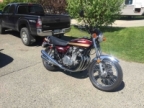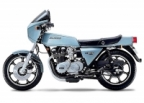Oxygen sensor & fuel/air ratio
- 73z1
-
Topic Author
- Offline
- Sustaining Member
-

Registered
- Posts: 509
- Thanks: 146
Oxygen sensor & fuel/air ratio
21 Nov 2020 05:39
No eBay APP ID and/or Cert ID defined in Kunena configurationThis device reports the fuel/air ratio for motorcycles -
If you have one (or any system) please report your experience.
What is fuel/air ratio for original z1 at idle and 55 mph ?
If you have one (or any system) please report your experience.
What is fuel/air ratio for original z1 at idle and 55 mph ?
Please Log in or Create an account to join the conversation.
- M_a_t_t
-

- Offline
- Sustaining Member
-

Registered
- Posts: 254
- Thanks: 41
Re: Oxygen sensor & fuel/air ratio
21 Nov 2020 06:18 - 21 Nov 2020 06:21
No eBay APP ID and/or Cert ID defined in Kunena configurationI haven't used that, nor do I own a z1, but I used these in my car. It is much cheaper and appears accurate. My car has lean on cruise, it is supposed to lean the mixture out once you get to highway speeds. That is why I bought it because it is otherwise stock and I wanted to see when it was going lean. I included the short video to show it in action. The number it was displaying is what I was reading others had said they saw with more expensive kits on their cars. For the bung I used a spark plug non-fouler from the parts store.
And:
www.amazon.com/gp/product/B077DR4TF9/ref...00_s00?ie=UTF8&psc=1
And:
www.amazon.com/gp/product/B077DR4TF9/ref...00_s00?ie=UTF8&psc=1
83 KZ1100A (shaft)
17 Versys X 300 abs
81 kz650h1
81 kz750e2
90 Honda CBR600F (brother's)
17 Versys X 300 abs
81 kz650h1
81 kz750e2
90 Honda CBR600F (brother's)
Last edit: 21 Nov 2020 06:21 by M_a_t_t.
Please Log in or Create an account to join the conversation.
- loudhvx
-

- Offline
- KZr Legend
-

Registered
- Posts: 10863
- Thanks: 1622
Re: Oxygen sensor & fuel/air ratio
22 Nov 2020 09:14
There won't be one single answer for all conditions. Outside temperature will have a great affect on idle AFR . Also, fuel formula may show an effect. A good target value when fully warm, on a warm day, will be around 12.5 for idle. The pilot screws may not end up in the stock position since your fuel may contain alcohol. 12 to 12.5 is usually the quoted value for best power.
At very light throttle, steady cruise, the mixture will probably be leaner than idle. You don't need "best power" in this condition. So an AFR of 13 or even 13.5 gives better mpg. If you open the throttle from that point, the AFR should drop significantly, possibly down to 10 or even 9 briefly.
AFR changes a lot for any change in throttle or RPM etc, so you really can't just stick with one number for AFR. You are really looking at trends in the AFR based on what you are doing with the throttle and what is happening with the RPM and load.
At very light throttle, steady cruise, the mixture will probably be leaner than idle. You don't need "best power" in this condition. So an AFR of 13 or even 13.5 gives better mpg. If you open the throttle from that point, the AFR should drop significantly, possibly down to 10 or even 9 briefly.
AFR changes a lot for any change in throttle or RPM etc, so you really can't just stick with one number for AFR. You are really looking at trends in the AFR based on what you are doing with the throttle and what is happening with the RPM and load.
1981 KZ550 D1 gpz.
Kz550 valve train warning.
Other links.
Kz550 valve train warning.
Other links.
Please Log in or Create an account to join the conversation.
- hardrockminer
-

- Offline
- Sustaining Member
-

Registered
- Posts: 3104
- Thanks: 1217
Re: Oxygen sensor & fuel/air ratio
22 Nov 2020 10:24
There is a fuel consumption curve in the Z1 Service Manual, one of the early pages. It measures fuel consumption vs rpm. You should be able to estimate the air volume at any rpm by using the swept volume of the cylinders times the number of rpm's.
I have several restored bikes along with a 2006 Goldwing with a sidecar.
Please Log in or Create an account to join the conversation.
- 73z1
-
Topic Author
- Offline
- Sustaining Member
-

Registered
- Posts: 509
- Thanks: 146
Re: Oxygen sensor & fuel/air ratio
22 Nov 2020 11:55
>>>>>>>>>>>>>>>>>>>>> There is a fuel consumption curve in the Z1 Service Manual, one of the early pages. It measures fuel consumption vs rpm. You should be able to estimate the air volume at any rpm by using the swept volume of the cylinders times the number of rpm's.
900cc * 1000 rpm * .5 (four stroke) = 450,000 cc per minute
900cc * 2000 rpm * .5 (four stroke) = 900,000 cc per minute
900cc * 3000 rpm * .5 (four stroke) = 1,350,000 cc per minute
900cc * 4000 rpm * .5 (four stroke) = 1,800,000 cc per minute
900cc * 5000 rpm * .5 (four stroke) = 2,250,000 cc per minute
Hardrock,
My guess for volumetric efficiency at 1000 rpm is 99%.
Please report efficiency at 5000 rpm
900cc * 1000 rpm * .5 (four stroke) = 450,000 cc per minute
900cc * 2000 rpm * .5 (four stroke) = 900,000 cc per minute
900cc * 3000 rpm * .5 (four stroke) = 1,350,000 cc per minute
900cc * 4000 rpm * .5 (four stroke) = 1,800,000 cc per minute
900cc * 5000 rpm * .5 (four stroke) = 2,250,000 cc per minute
Hardrock,
My guess for volumetric efficiency at 1000 rpm is 99%.
Please report efficiency at 5000 rpm
Please Log in or Create an account to join the conversation.
- hardrockminer
-

- Offline
- Sustaining Member
-

Registered
- Posts: 3104
- Thanks: 1217
Re: Oxygen sensor & fuel/air ratio
22 Nov 2020 17:25
I think those volumes have to be converted to grams in order to develop the air/fuel ratio.
I have several restored bikes along with a 2006 Goldwing with a sidecar.
Please Log in or Create an account to join the conversation.
- M_a_t_t
-

- Offline
- Sustaining Member
-

Registered
- Posts: 254
- Thanks: 41
Re: Oxygen sensor & fuel/air ratio
22 Nov 2020 20:27
I don't think so. It's a ratio so the units should cancel out.
You will need the density of the fuel to convert from volume to mass.
Is there a reason you aren't measuring it with the wideband either of us suggested and are trying to do it based on a graph in the manual? AFR is also load dependent so if that fuel consumption chart is just steady throttle in neutral at those rpms then it might only give you half the picture won't it?
You will need the density of the fuel to convert from volume to mass.
Is there a reason you aren't measuring it with the wideband either of us suggested and are trying to do it based on a graph in the manual? AFR is also load dependent so if that fuel consumption chart is just steady throttle in neutral at those rpms then it might only give you half the picture won't it?
83 KZ1100A (shaft)
17 Versys X 300 abs
81 kz650h1
81 kz750e2
90 Honda CBR600F (brother's)
17 Versys X 300 abs
81 kz650h1
81 kz750e2
90 Honda CBR600F (brother's)
Please Log in or Create an account to join the conversation.
- hardrockminer
-

- Offline
- Sustaining Member
-

Registered
- Posts: 3104
- Thanks: 1217
Re: Oxygen sensor & fuel/air ratio
22 Nov 2020 20:31M_a_t_t wrote: I don't think so. It's a ratio so the units should cancel out.
You will need the density of the fuel to convert from volume to mass.
Is there a reason you aren't measuring it with the wideband either of us suggested and are trying to do it based on a graph in the manual? AFR is also load dependent so if that fuel consumption chart is just steady throttle in neutral at those rpms then it might only give you half the picture won't it?
The fuel chart in the Z1 manual is in grams of fuel per horsepower-hour. So yes, the volume must be converted to grams of air if he wants to use the chart. I'm not saying that's the only way to do it, nor have I ever done it. It just occurred to me that the original question could be solved with that graph.
I have several restored bikes along with a 2006 Goldwing with a sidecar.
Please Log in or Create an account to join the conversation.
- DOHC
-

- Offline
- Sustaining Member
-

Registered
- Those Doe-Hawks really go!
- Posts: 1267
- Thanks: 595
Re: Oxygen sensor & fuel/air ratio
24 Nov 2020 11:46 - 24 Nov 2020 11:47
Whatever system you get, I think it would be very useful to have a data logging feature, and have the ability to add additional sensor inputs for engine RPM and throttle position. There are other things that may be useful as well, but that seems like the minimum set.
If you're brave, you could stare at the gauge while doing a wide open pull, and use that to tune the main jets. But every other carb adjustment would be very difficult without datalogging AFR,RPM, and throttle position.
With the data log, you can do a series of pulls at different fixed throttle openings. You can do quick throttle changes. You can just ride around. And then you can look through all of those different conditions and figure out where you need to tweak each of the different circuits.
If you're brave, you could stare at the gauge while doing a wide open pull, and use that to tune the main jets. But every other carb adjustment would be very difficult without datalogging AFR,RPM, and throttle position.
With the data log, you can do a series of pulls at different fixed throttle openings. You can do quick throttle changes. You can just ride around. And then you can look through all of those different conditions and figure out where you need to tweak each of the different circuits.
'78 Z1-R in blue
, '78 Z1-R in black,
'78 Z1-R in pieces
My dad's '74 Z1
'00 ZRX1100
My dad's '74 Z1
'00 ZRX1100
Last edit: 24 Nov 2020 11:47 by DOHC.
Please Log in or Create an account to join the conversation.
- loudhvx
-

- Offline
- KZr Legend
-

Registered
- Posts: 10863
- Thanks: 1622
Re: Oxygen sensor & fuel/air ratio
24 Nov 2020 13:46 - 24 Nov 2020 13:49
I developed a system that worked pretty reliably. No data logging, just holding steady throttle positions and looking at the gauge. Letting the RPMs climb to their real-world limit under a steady throttle lets you see the leanest condition you can expect for light cruising. It takes time, but you don't have to do anything special besides cruise at a steady throttle. That covers all of the low to mid range positions. Then for larger throttle positions, you watch the needle and see where it ends up during low gear acceleration tests. As long as it ends up at about 13 at the leanest, you know you will be accelerating through the most powerful AFR range.
There are some things that data logging won't log, which will be important to understanding the results. Head-wind gusts or slight up-hill and down-hill sections will change the RPM and thus the AFR for a given steady throttle.
There are some things that data logging won't log, which will be important to understanding the results. Head-wind gusts or slight up-hill and down-hill sections will change the RPM and thus the AFR for a given steady throttle.
1981 KZ550 D1 gpz.
Kz550 valve train warning.
Other links.
Kz550 valve train warning.
Other links.
Last edit: 24 Nov 2020 13:49 by loudhvx.
Please Log in or Create an account to join the conversation.
- DOHC
-

- Offline
- Sustaining Member
-

Registered
- Those Doe-Hawks really go!
- Posts: 1267
- Thanks: 595
Re: Oxygen sensor & fuel/air ratio
25 Nov 2020 13:41
Sure, it seems like plenty of folks get by with just a gauge. But if I had the choice, I'd prefer to look at the gauge readings from the comfort of my desk. 
Your comments about head-winds and hills is basically referring to engine load. Looking around, it seems like air-flow data is a good way to estimate engine load. Another is using manifold pressure (with RPM, throttle pos, and other things) to estimate load.
Adding a MAP to the sensor input set would probably be good. But it still seems like, with just RPM and throttle, you could make educated guesses about the load conditions you're looking at.
Plus, there aren't that many knobs to turn. With fuel injection you have 3D maps for timing and fuel and cam and everything else. With carbs you have main, pilot, needle position, and maybe accelerator pump. The effect of the first three are each very dependent on the throttle position, so it seems like looking at specific throttle positions over various load conditions (even if you're eyeballing load) should show which way you might want to move those. And the accel pump would be whacking the throttle open a bunch of times.
Also, I'm assuming carbs are designed to adapt to various engine loads, for a given fixed throttle position. That would be to maintain a roughly constant air/fuel ration as engine load changes. How else would they work?
If you're talking about optimizing the throttle cutaway, the needle taper, or messing with pilot air jets then you need a lot of time and better equipment.
Your comments about head-winds and hills is basically referring to engine load. Looking around, it seems like air-flow data is a good way to estimate engine load. Another is using manifold pressure (with RPM, throttle pos, and other things) to estimate load.
Adding a MAP to the sensor input set would probably be good. But it still seems like, with just RPM and throttle, you could make educated guesses about the load conditions you're looking at.
Plus, there aren't that many knobs to turn. With fuel injection you have 3D maps for timing and fuel and cam and everything else. With carbs you have main, pilot, needle position, and maybe accelerator pump. The effect of the first three are each very dependent on the throttle position, so it seems like looking at specific throttle positions over various load conditions (even if you're eyeballing load) should show which way you might want to move those. And the accel pump would be whacking the throttle open a bunch of times.
Also, I'm assuming carbs are designed to adapt to various engine loads, for a given fixed throttle position. That would be to maintain a roughly constant air/fuel ration as engine load changes. How else would they work?
If you're talking about optimizing the throttle cutaway, the needle taper, or messing with pilot air jets then you need a lot of time and better equipment.
'78 Z1-R in blue
, '78 Z1-R in black,
'78 Z1-R in pieces
My dad's '74 Z1
'00 ZRX1100
My dad's '74 Z1
'00 ZRX1100
Please Log in or Create an account to join the conversation.
Moderators: Street Fighter LTD



